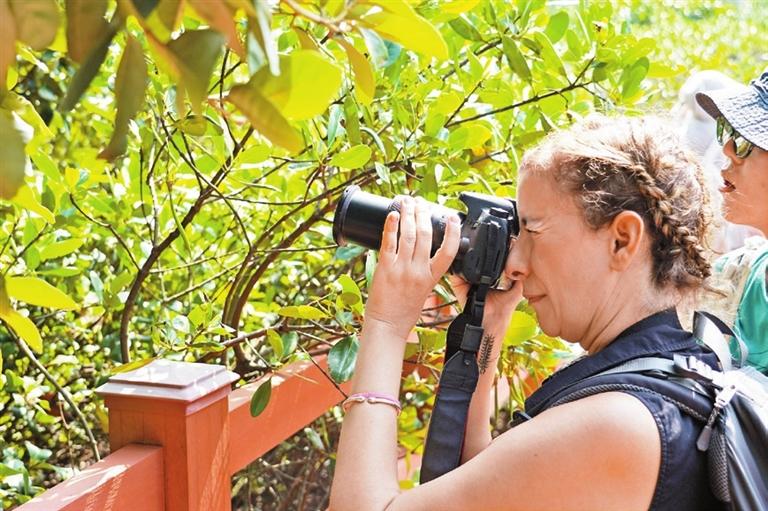

On a bright and sunny Sunday, a group of about 12 expats and nature enthusiasts — primarily researchers, teachers, and students — stepped out from their campuses to explore Baguang Heritiera Wetland Park in Dapeng New District.
The event, themed “Exploring Nature’s Beauty and Ancient Wonders in Baguang,” was co-organized by the Shenzhen Municipal Science, Technology, and Innovation Bureau and EyeShenzhen, with support from the Dapeng New District Urban Management and Law Enforcement Bureau, the Dapeng New District Construction and Development Center of Key Areas, and the Baguang Nature School.
Guided by Ou Wei, vice principal of the Baguang Nature School, and other volunteers, the group consisted of expats from the U.S., France, Portugal, Sri Lanka, South Africa, Russia, Ukraine, and Indonesia. They navigated the dense mangrove forests, listening intently to the volunteers’ explanations about various plant species and the intricacies of the mangrove ecosystem.

The common names of Heritiera littoralis — looking-glass mangrove or silver-leaf mangrove — stem from the distinctive appearance of its leaves, which are green on one side and silver on the other. Within the wetland park stands an ancient cluster of silver-leaf mangroves, recognized as the oldest and most intact natural grouping of its kind in China and the world.
According to Ou, the silver-leaf is a valuable species of mangrove, and this ancient mangrove cluster plays a vital role in the mangrove ecosystem. In addition to silver-leaf mangroves, the forest is home to other notable species, including Avicennia marina, Kandelia obovata, Acanthus ilicifolius, Excoecaria agallocha, Aegiceras corniculatum, and Bruguiera gymnorrhiza.
Volunteers Huang Guo, Du Cao, and Sun Pingnyu also introduced various animals that inhabit the park, such as fiddler crabs, hermit crabs, and mudskippers. The expats caught glimpses of butterflies and birds as they explored the area. They paused to admire the lush mangrove forest and wildlife, capturing the beauty of this unique ecosystem with their cameras and binoculars.

Ou shared additional insights into the park’s history, including information about Yanzao Village — a 300-year-old Hakka settlement — along with eco-education initiatives and nature conservation efforts.
Ana Gouveia, an assistant professor at the Institute of Environment and Ecology at Tsinghua Shenzhen International Graduate School, has visited mangrove forests in places like Indonesia and Futian District. She noted that this was her first time seeing looking-glass mangroves with parts of their roots exposed above ground.
Through the event, Gouveia learned about the city’s mangrove conservation efforts, which are led by the city and the Baguang Nature School. “The volunteers are professional and knowledgeable,” she remarked, acknowledging their commitment to protecting the area and raising awareness among visitors.
“For research, this is also very important,” Gouveia added. “If we have these areas accessible to us as researchers, we can understand how ecosystems work and how to protect them.”
Salindra Dayananda, from Sri Lanka, brought a notebook to record the species he observed. “So far, in one hour, I’ve seen 12 butterfly species and 12 bird species, including kingfishers and egrets, and other small creatures like crabs,” Dayananda said.

Dayananda, a postdoctoral researcher at the Institute of Environment and Ecology at Tsinghua Shenzhen International Graduate School, focuses on birds and butterflies. He mentioned that the journey to this remote area from the city center could inspire his research and help him identify the factors influencing biodiversity in urban environments.
Maria Monteiro, a French teacher from Shekou International School, expressed that the mangrove forest allowed her to perceive the communication among plants and the continuity of life. Highlighting the importance of nature education for children, she said, “We are part of nature. We can find all the solutions in nature, even to guide our own lives.”
In 2023, the ancient looking-glass mangrove cluster in Baguang was selected as one of the 100 Most Beautiful Ancient Tree Clusters in China, and it is the only mangrove cluster included on the national list. It was also recognized as one of the 10 Most Beautiful Ancient Tree Clusters in Guangdong Province in 2022.